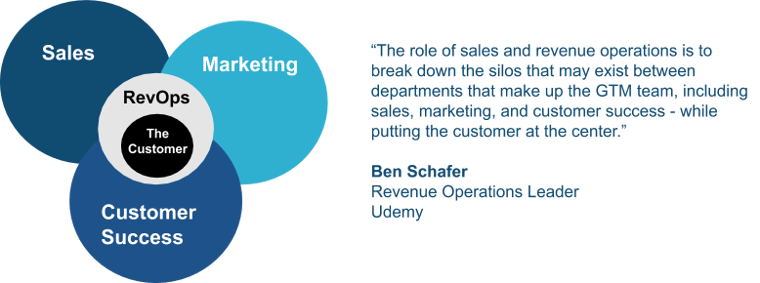Topics covered in this article
We all know by now that there is a rise in RevOps – a centralized function that traditionally was siloed across Sales Ops, Marketing Ops, and Customer Success Ops. So what does this mean for you? How do you shift from what was previously a sales operations function to a revenue operations function? What steps do you need to take now, and what tools are available to assist you in this transformation. Read on, and we will share our thoughts and viewpoint from our perspective as a revenue intelligence software provider.
So what is RevOps?
Lots of people seem to struggle with this term. It is often used interchangeably amongst a role, a function, and even a sales tool. We know that there is a need to centralize your people, data, processes, and tools to make this transformation.
Here’s my take. Revenue Operations, or RevOps, is a strategic function AND role that helps organizations and their customers achieve revenue excellence.
RevOps should be centered around the customer’s long-term value (LTV). Not sales, not marketing, not customer success. Yes, those functions are hugely important to ensure customer LTV. Still, if you orient everything around enabling these teams to provide the best customer experience, then your customers win, and in turn, you win.

RevOps has seen tremendous growth over the last two years. You will now see revenue operations as prominently as you will see sales operations now. So what’s the difference? Many people have differing opinions on this.
Sales Operations: Coined in the 1970s by Xerox to do the “dirty work” to make sales perform better. Now sales operations exist to reduce the friction in the sales process by enabling sales to be more productive, efficient, and ultimately successful (by driving revenue).
Revenue Operations: RevOps is at the center of the revenue engine; some would say a fundamentally new operating model for the B2B revenue engine. Their job is to align sales, marketing, finance, and customer success teams across a full customer life cycle, improve LTV, and drive growth while improving operational efficiency. Oh, and ensure everyone is accountable for revenue.
So what's the difference?
The primary difference comes down to this. RevOps centralizes and rallies the GTM and revenue team in terms of people, processes, data, and tools. They provide complete operational oversight across the revenue team, removes friction across all teams, not just sales, and provides strategic oversight on all processes and the tools and technology needed across the teams: Marketing, Sales, and Customer Success.
So what's the RevOps trend?
According to a recent 2020 LeanData report:
- 58% of B2B organizations have a dedicated Revenue Operations (RevOps) group in place already or are in the process of building one.
- 80% is the YoY increase in the number of organizations currently building this function.
- 30% of these organizations see measurable improvements with their GTM efficacy from RevOps.
Many organizations create RevOps functions to align themselves better internally to drive revenue growth and build a Ferrari-like revenue engine. One thing that is for certain, B2B organizations that align their revenue engine grow 12-15 times faster than their peers and are 34% more profitable. Now that’s a case for a centralized revenue function focused on revenue excellence. I don’t want to imply that no sales operations functions perform as a RevOps function and vice versa.
What I am seeing is that in some organizations and in some cases, these functions (Sales Ops and RevOps) are used interchangeably.
Has COVID further accelerated the rise of RevOps?
The impacts of COVID has accelerated the digital transformation in sales and has furthered solidified the need for a RevOps engine in three fundamental ways:

- Remote selling and the need to be connected: Need tools that connect the buying team and selling team. Provide visibility into all activity, engagement (and lack of activity), and deal progression. [*96% of B2B sales teams have fully or partially shifted to remote selling.]
- Remote teams and the need to drive efficiency: Need to create accountability and transparency into the sales process. Maximize team productivity and enable sales coaching opportunities. [*79% prefer video to phone when meeting with others internally.]
- Transparency and the need to drive predictability: Need to drive predictability in the sales process with visibility into activity, engagement, and risk with predictive-AI guidance that drives forecast accuracy and reliability. [*89% expect remote selling to be here for the long haul.]
Source: *2020 McKinsey & Company Report.
So given these trends and the need to centralize your revenue strategy, data, tools, and processes, I would say we have “fully entered the decade of RevOps.”
In the second part of this blog, we’ll tackle the topic, “Defining Success with Revenue Operations.”





-Photoroom.png)